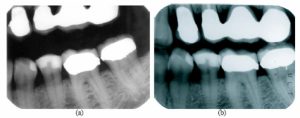Forensic dentistry or forensic odontology is a discipline that applies dental knowledge to criminal and civil laws. It is responsible for areas including identification of found human remains, identification in mass fatalities, and age estimation.
The first case in which a dentist used dental evidence in a court case demonstrated the method of Comparative Dental Identification. In 1814, a lecturer of anatomy Dr. Granville Sheep Pattison and two of his students in Scotland were charged for the violation of Mrs. Mc Alister grave. They have moved the body of Mrs. Alister after the burial to the nearby college. Mrs. Alister’s dentist Dr. James Alexander testified that the maxillary denture of one of the heads in the dissection room fit Mrs. Alister. The dental identifications of individuals are also effective after mass fatalities, such as the Sumantra Andaman earthquake and Tsunami waves in Indian Ocean in 2004. More than 92% of non-Thai were identified ,and out of them 80% were identified by dental formation.
The dental features on postmortem remains can be compared with ante mortem dental records, including written notes, study casts and radiographs. In the system of identification, dental restorations, similarities and discrepancies are noted. How are the discrepancies formed? In some cases, they are related to time lapse between ante mortem and post-mortem records; while in other situations, the discrepancies are unexplainable. Thus, there are four conclusions recommended when reporting identification results: positive identification, possible identification, insufficient evidence, and exclusion.

Postmortem PM (a) and ante mortem AM (b) dental radiograph with many restorations (dense radio opacity)
One process about forensic dentistry is to recover the life of a set of human remain: we can not only identify this person’s physical features, but also decipher the life experiences, such as socio-economic status includes occupation, dietary habits, and habitual behaviors, dental or systemic diseases. Erosion can suggest alcohol, substance abuse, an eating disorder or even hiatus hernia, while stains can indicate smoking, tetracycline use or betel nut chewing. The quality, quantity, presence or absence of dental treatment may indicate socioeconomic status or country of residence. These dental profiles can help forensic artists construct a facial reproduction.
Forensic dentistry is also utilized to determine the age, ancestry, and sex. For example, in 1897, due to the story which said another child instead of Prince Louis XVII was buried in the monument, three experts aged the skeleton near the side of the church at between 16 plus and 18 plus years, proving that the remains were not Dauphin. What’s more, a forensic dentist can determine race within three major groups (Caucasoid, mongoloid and negroid) from skull appearance and tooth features such as cusp of Carrabelle, shovel-shaped incisors and multi cusped premolars. Sex can be examined by the presence or absence of y-chromatin and DNA analysis.
References:
https://www.ncbi.nlm.nih.gov/pmc/articles/PMC4439663/
https://www.ncbi.nlm.nih.gov/pmc/articles/PMC4111024/
Campbell JM. Glasgow: Pickering and Inglis, Ltd; 1963. Dentistry then Now.
Schuller-Götzburg P, Suchanek J. Forensic odontologists successfully identify tsunami victims in Phuket, Thailand. Forensic Sci Int. 2007;171:204–7.
Craniofacial identification by comparison of antemortem and postmortem radiographs: two case reports dealing with burnt bodies. Campobasso CP, Dell’Erba AS, Belviso M, Di Vella G Am J Forensic Med Pathol. 2007 Jun; 28(2):182-6.
Body identification guidelines. American Board of Forensic Odontology Inc. J Am Dent Assoc. 1994 Sep; 125(9):1244-6, 1248, 1250 passim.
Amoedo O. Paris: Masson Co., Booksellers L’Academie of Medicine; 1898. Dentistry in Forensic Medicine.
[Studies on sex determination using human dental pulp. II. Sex determination of teeth left in a room]. Adachi H Nihon Hoigaku Zasshi. 1989 Feb; 43(1):27-39.
Review A look at forensic dentistry–Part 1: The role of teeth in the determination of human identity. [Br Dent J. 2001]
Further Reading:
https://www.ncbi.nlm.nih.gov/pmc/articles/PMC4149164/
https://www.adc-fl.com/dental-anthropology-and-bioarchaeology/
Images:
https://www.ncbi.nlm.nih.gov/pmc/articles/PMC4439663/


What is there that teeth or DNA can’t tell us? While you may be able to make guesses, what is there that DNA or analyses of decay obscure? For example, my mother has terrible teeth: when she was pregnant with me, she had horrible morning sickness everyday. Her teeth are brittle and thin, and if an archaeologist were looking at her sample, it would suggest that perhaps she were poor and didn’t take care of her teeth. When, in fact, she does, I just ruined them as a baby. Also, gender. Gender is not always expressed or experienced in the same way as chromosomal DNA let’s us understand. Any thoughts on this?
If I make speculations on the question in your example, my guess is that the forensic dentist will find the dental treatment marks on your mother’s teeth despite her teeth’s poor condition. Also, if she does see the dentist, forensic dentist can match her radiographs record before death with the forensic record.
There are some other limitations in forensic dentistry caused by a person’s life experience. For example, rugoscopy—the study of palatal rugae—can be used as a supplement in population differentiation, but “denture wear, tooth malposition, and palatal pathology can cause alterations in rugae patterns”. Also, postmortem damages of the remain can mislead the forensic observation of enamel rods and radiographs. (Kavitha et al. 2009)
As for gender, although people’s gender identities are not always expressed as our general assumption based on DNA, and their certificates may correspond with the gender identify, dentists can match the biological sex indicated in the 23rd pair of chromosomes with the record of the decedent’s sex at birth. After the identification, the decedent’s gender on certification likely corresponds with their gender identity. For example, in California, the Respect After Death Act “stipulates the death certificate must reflect the decedent’s gender identity” (Davis 2015). I think finding out the original biological sex would be useful in forensic identification but may not be useful in cultural anthropology studies.
References:
Davis, Simon
2015, Transgender People Are Misgendered, Even in Death, https://www.vice.com/en_us/article/exm3v4/transgender-people-are-misgendered-even-in-death-120, accessed October 22, 2018
Einstein, A; Kavitha, B; Saraswathi, TR; Sivapathasundharam, B
2009, Limitations in forensic odontology, Meenakshi Ammal Dental College, http://www.jfds.org/article.asp?issn=0974-2948;year=2009;volume=1;issue=1;spage=8;epage=10;aulast= DOI:10.4103/0974-2948.50881, accessed October 22, 2018